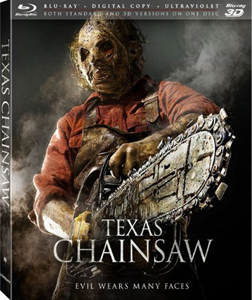Unlike many slasher hits, 1974’s “The Texas Chainsaw Massacre” didn’t immediately yield a ton of sequels. The first came out in 1986, and it was a comedy making fun of the franchise and genre. Today, there are eight “TCSM” films, but it wasn’t until the seventh entry, “Texas Chainsaw” (2013) (“Texas Chainsaw 3D” if you saw it in the 3D format) that the story picks up directly after the events of the original film.
A fundamental misunderstanding
The team of four writers (and this is a four-writer film if there ever was one) immediately squander the opportunity to dig into the dark corners of the rural Texas human-meat-processing family operation. Showing a misunderstanding of what makes “TCSM” scary, this sequel imagines there were other, more normal members of the family (named the Sawyers here) in the house while the four men were terrorizing Sally (Marilyn Burns, who cameos here in both archival footage and a new role).
This does not remotely ring true; it’s Sally’s distance from civilized society that makes her night of being tied up at the dinner table so scary. It’s possible that these normal members of the Sawyer family came over the next morning, but that also undercuts the creepiness of the family’s operation.
Slightly more plausible is the idea that militant rednecks around the area are suspicious of the Sawyers, but I would’ve preferred a story about their learning process about all the missing folks in the area rather than what we get.
As the sheriff (Thom Berry) – having heard Sally’s tale offscreen — tries to peacefully arrest Leatherface/Jed Sawyer (Dan Yeager), the rednecks “back him up” and burn the house to the ground, killing everyone except a baby.
Indeterminate future
So after this cold open to director John Luessenhop’s sequel squanders and simplifies all the compelling parts of “TCSM,” we jump ahead an indeterminate number of years to the story of the grown-up version of the baby, Alexandra Daddario’s Heather Miller.
She has inherited a rural Texas mansion that belonged to another Sawyer, who was not part of the blaze. Daddario was 26 at this time, and Heather and her friends are doing 20s things like taking a road trip in a van, so mathematics — along with flannel shirts — tells us this is the late ’90s, maybe 2000.
Later, a deputy uses a smartphone video camera to show his progress through the blood-soaked mansion to his superiors. So that would place the events contemporary with the film’s release. Plus, the actors playing the sheriff and the rednecks – their leader (Paul Rae) is now the mayor – are played by the same actors, so it’s a stretch to say more than 20 years have passed. So maybe we have to reset “TCSM’s” events in the 1980s or even the early ’90s, even though they were clearly in 1974?
No one is likable
I’ve already given this story more thought than the filmmakers have, which is a sign of a shoddy movie. Also problematic is that none of the characters are likable. Daddario is gorgeous, and a competent actress. But in order to make her arc believable, Heather has to decide over the course of these events that she dislikes her friends – including boyfriend Ryan (Trey Songz) – enough to side with their killer, Leatherface.

The best “Texas Chainsaw” can do is to make everyone selfish, from a hitchhiker (Shaun Sipos) who pounces on the opportunity to steal from the mansion to a supposed best friend (Tania Raymonde) who can’t keep her paws off Ryan. Or at least bland, in the case of Kenny (Keram Malicki-Sánchez), whose nice-guy status doesn’t save him from Leatherface’s wrath.
Not-so-subtle special effects
Everything about the story and character motivations falls apart with the slightest bit of thought, but “Texas Chainsaw” isn’t without its appeal. The special effects team, led by “The Walking Dead’s” Greg Nicotero, delivers some cutting-edge (pun intended) gore shots, including a dude being sawed in half.
This is a complete 180 from the original, which implied everything. That’s one of the reasons the original is so much better. Here, a viewer can abstractly appreciate the artistry, but that’s about it, because the story never pulls us in.
Another strength, in the abstract, is the mansion Heather inherits. I love old architecture that includes secret passageways and sub-basements. The idea of Leatherface living in the bowels of the house is creepy – until it isn’t anymore. Other settings also provide some atmosphere, including a carnival and a slaughterhouse, site of a particularly gruesome kill.
Luessenhop delivers a couple evocative scares that tap into primal fears: Running from a threat up the basement stairs; spotting a corpse in a chair in a mirror. Those well-staged moments stay in a vacuum, though, rather than serving as notes that build to a crescendo of horror.
And the notion of Heather befriending Leatherface remains unbelievable, no matter how ambivalent she might’ve been toward her friends. Only a tour-de-force performance on par with Burns’ from the 1974 original could’ve pulled off what this screenplay is sloppily aiming for. Instead, Daddario is merely a competent, run-of-the-mill Final Girl — totally forgettable, like everything else about “Texas Chainsaw.”
Click here to visit our Horror Zone.

“Texas Chainsaw Massacre” series reviews
“The Texas Chain Saw Massacre” (1974)
“The Texas Chainsaw Massacre 2” (1986)
“Leatherface: The Texas Chainsaw Massacre III” (1990)
“Texas Chainsaw Massacre: The Next Generation” (1995)
“The Texas Chainsaw Massacre” (2003)
“The Texas Chainsaw Massacre: The Beginning” (2006)
“Texas Chainsaw” (2013)
“Leatherface” (2017)


